page 19
Progressive Thinkers as of 5/8/2020
|
| ||||||||||||||||||||||||||||||||||||||||||||||||||||||||||||||||||||||||||||||||||||||||||||||||||||||||||||||||||||||||||||||||||||||||||||||||||||||
Regardless if one feels they have an uncanny knack for finding a particular number pattern in different subjects or that they are slightly obsessed with a particular number, a person is able to construe any number of explanations for a given recurring occurrence, though I might add that a person can encounter multiple instances of repetition (of numbers, songs, feelings, intuitions, etc.,) and yet not be consciously aware of them to the extent they attempt to devise some model of explanation and meaningfulness to themselves. For example, Even if you recurringly see a reference to a particular time (such as waking up at 1:11), or find yourself looking repeatedly at a clock when it is 2:22 or 3:33, or 4:44, or 5:55 or some mixed variation... all of them signify a pattern-of-three you have come to personally (and perhaps preferentially) particularized. One classic example of someone claiming to see the value "7" multiple times is expressed by George A. Miller (1956) in his highly recognized paper entitled "The Magical Number Seven, Plus or Minus Two: Some Limits on Our Capacity for Processing Information".
"My problem is that I have been persecuted by an integer. For seven years this number has followed me around, has intruded in my most private data, and has assaulted me from the pages of our most public journals. This number assumes a variety of disguises, being sometimes a little larger and sometimes a little smaller than usual, but never changing so much as to be unrecognizable. The persistence with which this number plagues me is far more than a random accident. There is, to quote a famous senator, a design behind it, some pattern governing its appearances. Either there really is something unusual about the number or else I am suffering from delusions of persecution." (Contents of Paper by George A. Miller, 1956)
Unfortunately, for those who favour the value "7", and for many people who read the title, they remain oblivious to the associate 'three' pattern in the form of an equation: (7 + or - 2) = {7 + 2 = 9] and [7 - 2 = 5]. Hence, the pattern is 5- 7- 9 as a type of three-patterned ensemble. (Though one can easily move the numbers around to created different combinations as if playing a Three shells and a pea game which is similar to the Three Card Monte, to which we might add the Rock, Paper, Scissors betting activity as a variation (and the manner in which one holds a hand can be interpreted to represent the counting scheme of "1- 2- Many".) Other types of three-patterned ensembles exist. Take for example this list: 2- 3- 4 patterned ensembles.
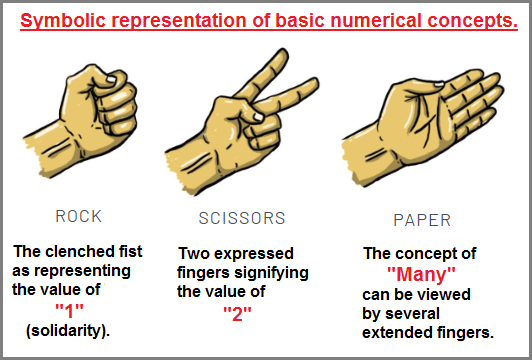
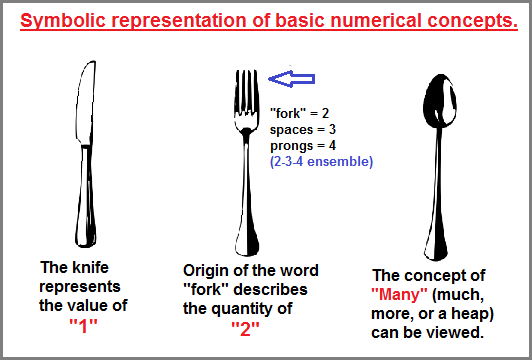
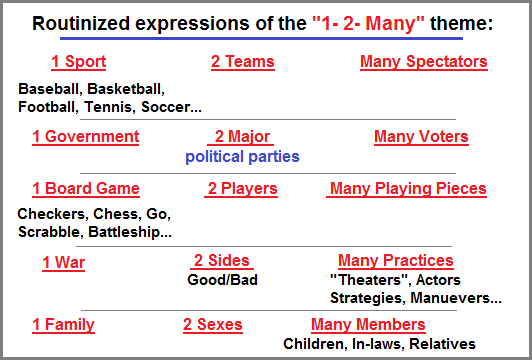
There is no telling (at least I know of no survey which asks the question), of how many people have a similar experience with some number or other pattern (similar to that expressed by George A. Miller). Indeed, in the development of primitive counting efforts, one might surmise one or more early counters were "obsessed" or plagued by am impulse to use a line to illustrate the concept of one, such as the scratch marks found on rocks, sticks and bones thought to be primitive tally sheets. More formal or later developments of enumeration involved a circle, dot or circular illustration. Later illustrations involved a wedge or triangle-shaped configuration long before the advent of numbers as we know them today. Clearly there was some sort of "1" quantity concept period followed sometime by a "2" or pairing concept, followed by the notion for greater quantities by some encapsulating word such as "Many" (or some language equivalent much, more, plenty, heap, pile, "all the rest", etc..), which was used to described what may have at the time been thought of as a close approximation to our present use of the word "infinity"; which in itself may be little more than a primitive concept compared to the ideas which will arrive on the scene of human intellect hundreds, thousands, or millions of years from today.
Whereas one might think that the use of lines, circles and triangles to express a sequential development of enumeration has vacated the human mind by being placed with numbers, if we look closely at mathematics we can see all to well that these three geometric forms are still in use in varying ways. Just because a straight line has become substituted with a line and one or two curved ends, doesn't mean the primitive association of number is no longer used. Indeed, where would mathematics be without the circle called a Zero, or without the triangle being used to signify less than and greater than? An examination of the Line, Circle Triangle idea may be of some interest to a few readers.
We as a species need to know how often (and how many) people have similar experiences to that described by George A. Miller, and not automatically describe them in some disparaging superstitious or Numerology sense. This just as it is of value to ascertain which board game is most played, if not for the sake of gaining knowledge for some commercial interest, but then to understand the frame of mind humans attach themselves to; which may help us to grasp which orientations and limitations are being repeated in order for us to understand cognitive changes which may or may not be directly attributable to what may be described as a survival quotient of the human species that has been addressed by different scenarios but not subjected to any critical review or comprehensive data collection survey and estimation. Are such experiences due to a combination of factors such as personal, Familial and Culturally taught superstition, observance or as a projected substitution describing a personal level of persistence, energy and pattern recognizing ability used for stabilizing an otherwise wayward ability to perceive multiple items in different venues which favor some ancient form of hunter-gatherer activity that may be unrelated to typical gathering incentives such as hand-to-mouth feeding, drinking or social bartering advantage?
This site is about the collection and application of patterns using a "three" model such as for example the recurrence of "Threes" in Fairytales. Since this simple idea may not be known to a particular reader who either deliberately or chanced upon this site, let me provide a few examples of threes in Fairytales though they occur embedded in other types of children's literature, games, rules-of-thumb, as well as in poetry. Yet, it should be understood variations in the stories can and do occur, and that one must invite themselves to look at traditional tales from a Chinese perspective as discussed here: Where the West and China find common ground by By Maria Tatar, the John L. Loeb research professor at Harvard University, MAY 14, 2022, 7:00 AM.
- Goldilock's and the Three Bears. (Alternatively, we could view this as a Three-to-One ratio.)
- Old King Cole and his Fiddler's three. (Another 3-to-1 ratio.)
- Wynken, Blynken, Nod.
- The Three little Pigs. (Another 3-to-1 ratio when we include the wolf.)
- The Three Billy Goats Gruff.
- Three Kittens lost their Mittens.
- Three Magic Beans of Jack and the Beanstalk. (Yes, I know different versions have different counts of beans. Also; Magic harp, Bag of coins, Goose that lays Golden eggs.)
- Three Blind Mice.
- And here is a slightly longer listing: Threes Poster column 4
Fairytales, Legends and Myths are not typically described as (mathematically-oriented) word problems (despite their simple structure of narration). When we read "Goldilock's and the Three Bears", one might not automatically translate this into a ratio of 1 to 3 or its obverse of 3 to 1. Indeed, because the ratio occurs quite often, one might consider it to be a reference to a cognitively displayed ratio dependency. The realization of a 3-to-1 dependency related to basic numerical performance has been cited and is illustrated in this discussion: Primitive Concepts of Number and the Developing Human Brain by Alyssa J. Kersey and Jessica F. Cantlon. We find the same three-to-one ratio in genetics:
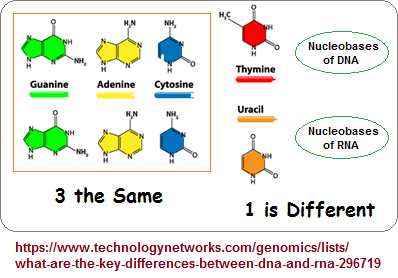
- DNA and RNA have the three (Adenosine- Cytosine- Guanine), and each has a separate entity of distinction: DNA = Thymine, RNA = Uracil.
- 3-to-1 ratio in Mendelian genetics:
A 3:1 Ratio is the relative fraction of phenotypes among progeny (offspring) results following mating between two heterozygotes, where each parent possesses one dominant allele (e.g., A) and one recessive allele (e.g., a) at the genetic locus in question—the resulting progeny on average consist of one AA genotype (A phenotype) for every one aa genotype (a phenotype) for every two Aa genotype (A phenotype), thus three A phenotypes for every one a phenotype.
However, it is more common to find a "four" label instead of a 3-to-1 ratio label, though such an idea can be scrutinized. Take for example basic tissue types:
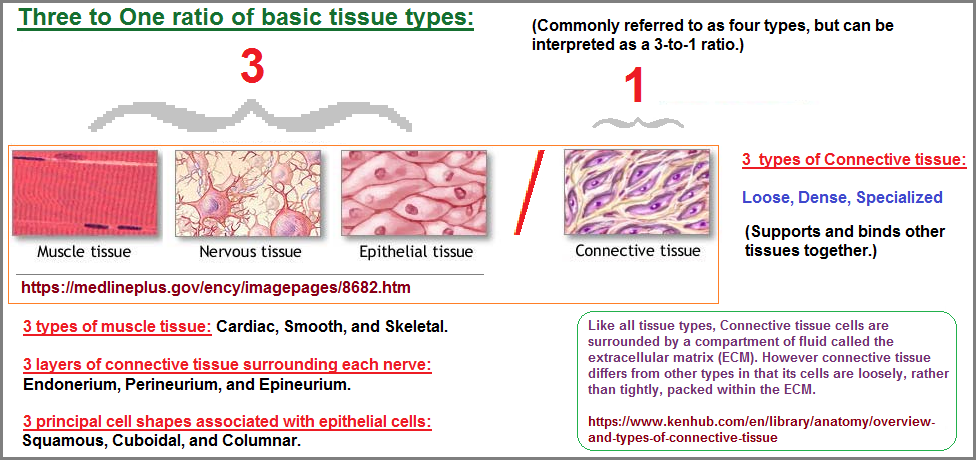
While the "four" quantity is not wrong, the use of a "3-to-1 ratio" may be more advantageous in order to find similarities of cognitive behavior in other subjects, since using the term "four" may be excluded if we are only searching for specifically-labeled 3-to-1 examples (and vice versa). While humans are casually referencing something as a "four", Nature itself may be using the idea of a 3-to-1 ratio, because it is working with proportionality in design and/or function and/or placement and/or frequency, much in the manner in which we proportion the items of 75% nitrate, 15% charcoal, 10% sulfur to produce gunpowder, or the "3rd" of a fractional charge for some atomic particles called quarks.
If we don't use the descriptive label of "3- to- 1", alternatively we can view the idea as 3 -in- 1, 3 -from- 1, 3 -and- 1, 3 -as- 1, etc., or the reversed order of these perceptions. In many cases what is typically designated a "four" can be viewed as a 3-to-1 ratio and must be viewed as part of the standard cognitive profile, or if you prefer... "standard cognitive spectrum", suggesting a spectrum of patterns much like a color or electro-magnetic spectrum. In simply terms, one may view a box of Crayola crayons as a spectrum of colors, though such a word is not typically part of one's vocabulary when speaking of crayons. Another example is the so-called four directions (North-South-East-West). While indeed there are four, we (English-speaking people) express the four in a 3 -to- 1 ratio way: North, South, East "and" West. The "and" is a point of demarcation between the first 3 and the next 1. We use this same conceptual framework when we write out a sequence of numbers involving a place-value system: For example, we use a "comma" between the ones-tens-hundreds(,) before indicating the next 1 which is the thousandths place. We repeat this same 3- to- 1 ratio sequence no matter how many numbers we use.
In as much as the value "three" has a high frequency of occurrence, other observers perceive different number patterns in addition to the three, to the extent that some writers may point out that Fairytales use the three numbers 3, 7 and 12, while another may reference the significance of the three numbers 3, 4, and 7 in Fairy Tales, Folklore, and Mythology. And at least one writer has this to say about "Threes" in Russian Literature:
Triplicity is particularly pervasive and profound in Russian culture and in Russian literature, as is shown by this tracing of "things in threes" from Russian pre-literary narrative forms through Pushkin, Lermontov, Gogol, Tolstoy, Dostoevsky, Gippius, Blok, Pasternak, and Pelevin, as well as in the works of criticism that treat them. (People in Threes Going Up in Smoke and Other Triplicities in Russian Literature and Culture by Lee B. Croft)
The article used to be online (readily accessible to anyone interested in the "threes" phenomena or Russian Literature) but has since been placed behind a paywall or some institutional requirement. Nonetheless, I added it long ago to my developing list of examples for those who may be interested: Professor Lee B. Croft's article. Professor Alan Dundez on the other hand describes the same pattern in his article The Number Three in the American Culture.
And yes, you may find in your research that some other number appears to be more prevalent in some other culture; but you probably do not initially come to further assess the fact that when you take all the prevalent numbers of all (or even a few or "many") cultures and set them side-by-side, you notice that only a handful of numbers are being used by humans, with respect to the infinity of numbers at our cognitive disposal. In essence, we have a "one" representing the "Many", a theme echoed in the Motto of the U.S. Presidential seal expressed in Latin as "E Pluribus Unum, described as "Out of Many, One". Hence, we have another example of the 3 to 1 ratio where the value of "3" is represented by the word "Many" as is indicated in the phrase of 1- 2- Many, and can be used as a generalized reference to primitive attempts to develop a counting sequence.

Interestingly, the concept of Infinity is illustrated by a single symbol and not some three-part equation such as E = MC2, or A2 + B2 = C2, or the 3 power equations used in electricity, not to mention ideas such as the Three Laws of Motion, Three laws of planetary motion, Rule of Three in writing, Rule of Thirds in photography, Rule of three in copy-writing, Rule of three in communication, Rule of Three in presentation, Three laws of Thermodynamics (if we include the Zeroth law, we have a 3-to-1 ratio), etc.... In other words, we don't find cultures who prefer a large number and thus find this number also being used in other subjects. And though you may think the number "7" or number "13" or number "666" are larger numbers than 1, 2 or 3, we don't find them being used with great frequency in multiple subjects. There is a consistently expressed usage of small numbers which appear to reflect a "conservation of number" has a heightened system of what we can presume to be for enhanced survivability... or at least an active system of rationalization in the context of an incrementally deteriorating environment.

In several cases like the two examples above, we find researchers deliberately focused on either the "three" or some idea involving three, where the "three" number is not explicitly looked for. Take for example Georges Dumezil's Tripartite Ideology of Indo-Europeans sometimes referred to as the Trifunctional Hypothesis. It deals with a singularly specific group-of-three being applied to the social stratification of multiple cultures (to which one might add the old standard of Upper- Middle- Lower social classes). Another specificity of three, this time found in psychology, is the Id, Ego, Superego idea of human personality developed by Sigmund Freud. And it matters not whether you believe in a particular three-patterned idea (take for example the Triune Brain concept developed by Paul D. MacLean of which there are several detractors claiming it (in short) to be a successful myth (just like the threes in Fairytales and perhaps even many present day Scientific theories, not to mention when viewing the Christian Bible as just another piece of literature).
Nonetheless, the fact remains that the use of the "three" is occurring and has occurred widely and needs to be explained such as being a standard cognitive pattern and/or as an environmentally influenced survival mechanism owing to the fact that the Earth is the 3rd planet, DNA uses a triplet code, the basic atom has three large particles (protons- neutrons- electrons), and we can find a lengthy List of Threes in human anatomy. In some cases a later civilization will come to adopt a three-part theme that may have been used singularly by one culture, and aha duple by another culture. An example of this is in the convention of giving a person a name. Not everyone has a first, middle, and last name, but it is a common idea used in multiple places. Apparently, one might consider it to have been derived from the Ancient Roman system of giving names. Why do we have middle names? by Merrill Fabry, in which the historian Karen Stern says: "They used a praenomen or personal name; a nomen, or family name, which “has the same placement as a middle name but has a different function"; and a cognomen, which, she says, was a nickname indicating an attribute or, eventually, what branch of a family you were from."
Those using the betting scheme of Rock- Paper- Scissors may not be focused in any particular way, but the fact that people have engaged in it, or used a small- medium- large sizing for the drawing of lots, says something about humans think. And even though we might argue about the "three" as a standard of thinking by supplying some example of an other-than-three organizational pattern such as the quantity of legs of a centipede which is between 15 and 177 pairs (How many legs does a centipede have?) or millipede which usually falls short of having 1,000 legs, but one such variety does exist: Finally, a Millipede That Actually Has 1,000 Legs; the point to be made is that most often we see small numbers, such as humans having two and quadrupeds having four. Hence, in a study of "threes patterns" when some other pattern(s) arise, one must note the absence of three BUT also note that a binary and subsequent multiple pairings might well be part of an overall three-patterned ensemble Which Nature uses but no one has as yet defined nor labeled as a consideration for further research. Large numbers appears to be a cognitive standard.
- For example, no culture plays Baseball with 50 strikes and you're out.
- Nor play basketball which allow for points to be gained beyond a three-point shot. (In other words, there are not four, five, six, etc., point shots in a typical game, unless one intentionally changes the rules to fit a particular game of play in a particular context such as amongst friends who are goofing around in a playful sense.)
- You don't find board games which provide for another kind of move other than the standard three: vertical, horizontal and diagonal. The idea of a zig-zag move can be explained as a combination.
- Similarly, we are on the 3rd planet from a Sun and not the 697th.
- DNA uses a triplet code and not a 17 or 58 or ten million coding system.
- Three divisions of cell organelles and other functions:
- General cell organelles: they are present in both animal and plant cells all the time – cell membrane, cytosol, cytoplasm, nucleus, mitochondrion, rough and smooth endoplasmic reticulum, Golgi apparatus, peroxisome, lysosome, and the cytoskeleton.
- Temporal (temporary) cell organelles: they are only found at specific stages of the cell’s life cycle – chromosome, centrosome, autophagosome, and endosome.
- Specific cell organelles: they only exist in the plant cells – chloroplast, central vacuole, and cell wall.
- Nor do we routinely rack billiards balls or bowling pins in a geometric configuration other than a 3-point triangle. (The diamond billiards rack can be viewed as two triangles.)
- Three types of Ecological Pyramid:

- Bowling balls regularly have three finger holes and the maximum points is 300. One may throw a strike, a spare or a gutter ball.
- Apparently, most people use three fingers to hold a pen or pencil to write with and end a sentence with a period, question mark or exclamation point..
- Three fingers are used in the standard grip for holding chopsticks, while some cultural settings prefer the use of three fingers to eat with.
- Likewise, there are not 73 Olympic medals. Typically there is a Gold for 1st place, Silver for 2nd place, and Bronze for third place.
- Horse race betting has been standardized with a Win- Place- Show scheme and not provide for 25 betting options.

- It is not typical to encounter a traffic light with more than the three colors of red- yellow- green.
- The three most-landed-on squares (while playing the board game called Monopoly) are "GO," the "B&O Railroad", and "Illinois Ave". (Top Ten Board Games of All Time)
- Three typical University degrees: Bachelor's- Master's- PhD.
- There are three main categories for (Archery) bow shapes: straight, recurve and compound.
- Three main types of firearms in the old American West: Pistols, Rifles, Shotguns
- Horse Spurs have three components:
- The branch or the yoke, which is the band that you wrap around the heel of your boots.
- The neck or shank that protrudes from the yoke. This part touches your horse.
- The rowels or disk with sharp points attached on the shank.
- Three types of dog leashes: Body harness- Around the neck, with a Muzzle
- In the categorization scheme of sizes utilizing the small- medium- large lineup, it is standard to use one, two or three X's along with a repetition of the "small" and "large" labels. No other words nor symbols are employed in this format.

- Washing machines exhibit a routine sequence of Wash- Rinse- Spin and are made to accept detergent, bleach and softener.
- Shampooing one's hair instructions: Lather- Rinse- Repeat
- Three main types of Refrigerators:
- Side-by-Side Refrigerators.
- French Door Style Refrigerators.
- Stacked Refrigerator and Freezer.
The reason for using multiple examples from everyday encounters is that most readers may not be familiar with many of the more technical examples derived from reading text book or technical data sheets involving a single circumstance or issue. However, a few of these types of examples are necessary for those readers who want to see more in depth examples from different subjects. Some people are more aware that Dale_Earnhardt drove a racing car with the number 3 on it then they are in the presence of the idea of three feeding types found in biology referenced as Carnivore, Herbivore, Omnivore or that feeds for horses can be classified as three main types: (1) roughages, (2) concentrates, and (3) mixed feeds (Feeds for Horses)> However, many an everyday vegetable gardener may be aware of the three main nutrients: Nitrogen (N), Phosphorus (P), and Potassium (K), (Vegetable Gardening: Selecting a Fertilizer). However, a simple household gardener may not be aware of the history of growing crops which has (historically) followed the transition of a 1 field, 2 field, 3 field system development.
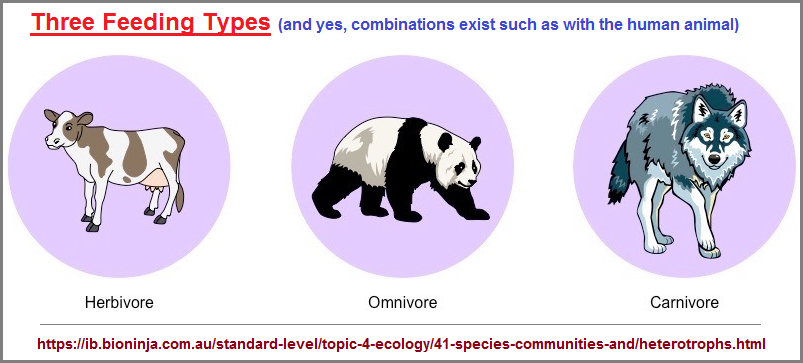

One person may be aware of the 3 general divisions of the Earth's geology as Core- Mantle- Crust, and that an insect is frequently divided into Head- Thorax- Abdomen, or that a Combo-meal at many a restaurant refers to three items, but are not familiar with the three wheel alignment adjustments of Caster, Camber, Toe. One person may be aware of multiple threes examples in the Bible, but not that the story of Jesus is suffused with them as described in this poem: Three Wise Men (English Version). While one person may be aware that Most modern acoustic/upright and grand pianos come with three pedals, they may be oblivious to the existence of three familys of particle physics which might be labeled as Stable- Unstable- Highly unstable. On the other hand, there may be readers who have come across that prisons frequently adopt a Three drug protocol for an execution, but will overlook the present of a 3-month illustration as an adopted standard in some workplaces. Multiple such situations exist amongst different readers.
The foregoing list is a thimble full of examples containing a "three" theme. In other words, we humans routinely focus on using certain low value numbers over and over again, and that often represent a serialization as if it were progressive or digressive (reversed) orientation: From A to B to C..., From 1 to 2 to 3..., From primary to secondary to tertiary, a (microphone) testing of 1- 2- 3, or an X, Y and Z when making a certain type of graph... etc... I mention the existence of examples which exhibit what can be interpreted to show either development or regression, so that the idea can be used in instances where one might not typically apply such a concept. A developmental progression can be seen when we cite the three Germ layers with three layers as representative of more complex (Triploblastic) life forms and two germ layer (Diploblastic) life forms as being less complex. For example, the human brain as we know it with its current complexity did not occur in the same developmental manner in the two-germ layer stage of life-form development.
At this point some readers may want to argue that they can make a list of some alternative pattern such as two, seven, etc., and may well begin to do so, but stop short when they encounter someone who has made a list and will thus reference the work of such a person instead of continuing in their own deliberations. However, none of them are discussing the presence of such patterns as exhibiting low numerical values. In other words, we do not find people making lists of numerical patterns involving any particular large number, though a large number may be referenced for a given examples. We do not find the larger number being used in several different subjects like that of small numbers. Indeed, even if you take a survey of those who are interested in numbers and are sometimes derisively referred to as a Numerologist because the associated word "Numerology" is seen by some to indicate a superstitious frame of mind; we encounter such people as Numerologists engaging in the development of lists with number-related examples exhibiting only a handful of numbers, most of which are low value numbers, or large numbers reflecting a compilation of single (or double or triple) numbers. They do not have lists which involve a large assortment of numbers existing in the infinity of numbers at our human disposal. You don't find Numerologists framing a special number out to hundreds of decimal places. The Numbers typically being used is a small assortment of usually small numbers with compilations of single numbers to create an amalgamation used as a pretended large number. As far as I'm concerned, Mathematicians are just a type of Numerologist that have found different ways for applying numbers..
My interest in a repeating "threes" model of occurrences also highlights an interest in acknowledging the absence of such a pattern and to (at least mentally) catalogue which (if any visible) pattern is present instead. Thus, while I have an interest in the "three" I am not oblivious to the presence of some other pattern and wonder why such a pattern is being used and whether two or more patterns together represent a larger meaning which can only be seen by using an enlarged appreciation of human cognitive activity set into a context where there is an ongoing need to adopt the strategy we called adaptation, thereby in an incrementally deteriorating environment such as all life on Earth exists, one might use the word "rationalization" as a means to include both biological and cognitive patterns which exhibit a constraint as suggested by the recurrence of low number values. Whereas it is not that humans lack the imagination to exceed using small numbers, but that human imagination is forced to abide by the imposed environmental constraints of an incremental deterioration.
Indeed, by taking stock of multiple events in Nature, we come to realize that for example, with respect to physics, Nature Seems to Love the Number Three by Mark Mahin. However, in these very early years of developing a computer system, Computers use a Binary language of 0's (zeroes) and 1's (ones) based on the off and on properties of an electronic circuit. And if one takes the time to really look at and catalogue the basic ideas in Mathematics, it too could then be seen as exhibiting a primitive two-patterned system such as add/subtract, odd/eve, real/imaginary, squared/cubed, greater than/less than, etc... In the former example there is a present day attempt to design a computer system with a trinary (ternary) language aside from the usage of a three-based (And- Or- Not) Boolean Logicwhile in the latter case mathematics has imposed its two-patterned will on so much of how society operates, far too few observers recognize the need for Mathematics to evolve towards a "third" perspective; beyond the mere applications of the three-part Pythagorean theorem and Trigonometry, (and despite the handful of Math related "threes" references one or another might list such as done here: Wikipedia 3).
In discussing the application of observing basic enumeration patterns in different subjects, I am describing basic cognitive patterns which very often describe a type of language being used in a given subject. However, in describing language carried over into the study of linguistics and grammar, all too often we find very serious and sincere researchers overlooking the application of hearing. You don't find those who study language commonly describing the process of hearing and in more particular, the recurring patterns that can be easily identified. Let me provide an example of the human ear with the recurrence of the "three" pattern and then associate this with the recurrence of "three" patterns in grammar (for example, genders: masculine- neuter- feminine, tenses: ring- rang- rung, sentence ending punctuations: period- question mark- exclamation point), and what appears to be the world standard for holding a pen or pencil with three fingers, not to mention those who eat with three fingers or those who subscribe to the three utensils (knife- fork- spoon) in contrast to those who not only use two chop sticks, but may prefer to orient themselves (publicly or privately) to a two-patterned yin/yang philosophy. it is simply ridiculous to speak of studying language when you don't take the auditory process into consideration and map out its recurring patterns, all the while knowing how difficult it is for a deaf person to learn vocal articulations... and also not consider the effects of language patterns on thought patterns (and vice versa).
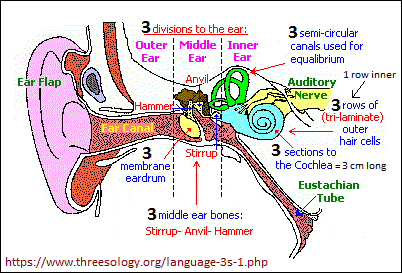
Is the recurrence of a 3-pattern in the ear a coincidence? A freak of nature? Perhaps you prefer to think of it as an anomaly or some mutagenic disease? And that just because we have multiple examples of 3-patterns occurring in multiple ideas in multiple subjects, this too is a coincidence and that you, because you prefer not to believe it, want to search for some other recurring pattern and yet still refuse to acknowledge that whichever pattern you provide it is a low number and this recurrence of a low number has nothing whatsoever to do with am imposed constraint... because your arrogance, your ego wants to believe your are not limited because you think you were made in the image of some limitless god? And even if you do come to acknowledge the recurrence and suggest to yourself there is something to be considered in such an idea, you will refuse to make public mention of it because the leadership in language research have not seen it and it is an idea not part of their fundamental language theory. If the so-called experts being paid thousands of dollars in Universities throughout the world are not discussing it, then it must not have any merit and you, a supposed seeker of truth, can discount it as being an irrelevant supposition. Whereas you may be one who insists that you can create a list just as large and displaying a different pattern, then by all means, please do so. And afterwards also recognize that the pattern you have chosen is a small number and that when you take stock of all lists of all patterns related to ideas covering multiple subjects, there is a conservation of number taking place with human cognition which needs to be addressed with an explanation which includes why Nature itself is using this same strategy... apparently as a survival mechanism in an incrementally deteriorating environment which may create more occasions for expressed "fusions".
(Second half of this page moved to page 20)
Date of (series) Origination: Saturday, 14th March 2020... 6:11 AM
Date of Initial Posting (this page): 1st March 2022... 6:04 AM
Updated Posting:Saturday, 1st October 2022... 10:03 AM, MST; Albuquerque, NM.